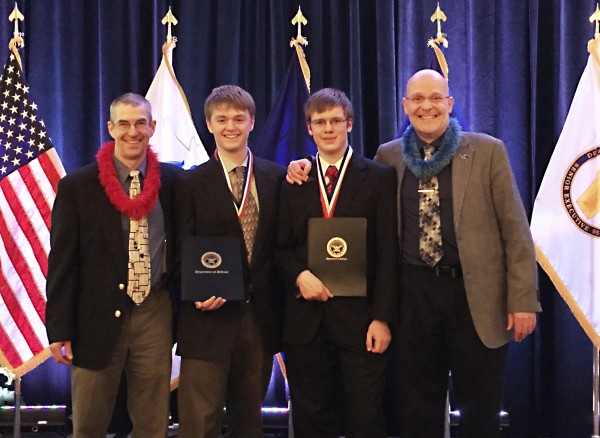Alaska high school students win top honors for research
May 12, 2015

Meghan Murphy
907-474-7541
05/08/15
Two Alaska high school students won top honors in a national competition for original scientific research.
Ian Fleming, of Petersburg, earned first place and a $12,000 scholarship for his research on the negative effects of a common herbicide on coho salmon eggs. Michael Kaden-Hoffmann, of Fairbanks, won fourth place and $300 for a poster detailing research that supports the recognition of three and not just two species of the plant dwarf rosebay (Therorhodion), which grows in Alaska.
Both students competed April 29-May 2 at the 53rd National Junior Science and Humanities Symposium in Hunt Valley, Maryland. They qualified for the competition after placing in the top five at the 30th Alaska Statewide High School Science Symposium, hosted by the University of Alaska Fairbanks College of Natural Science and Mathematics March 28-29.
Fleming, from Petersburg High School, won first place for his research and how he presented it in the competition category of “Environmental Science.” He said he wanted to see how coho salmon eggs would fare when exposed to different amounts of the common herbicide Roundup because it “was important to me, my family and the state.” At one point, he said, there was a proposed plan to use herbicides in Petersburg to control vegetation along roads that often cross over or run alongside streams where coho salmon and other species spawn.
Fleming said he entered ASHSSS as part of his AP Biology class, which required all the students to develop a research project for the symposium. His mentor was his father, Doug Fleming, who commercially fishes after a career as a fishery biologist in Alaska. Ian Fleming said the project helped him learn about the scientific method.
“I think it’s important to learn about the scientific method early on, because it doesn’t really change as you move through the different levels of education,” he said. “If you get exposed to it early, you can build off of it, become more precise at it and gain a greater understanding of how it works.”
Kaden-Hoffmann, from West Valley High School, used DNA tests to explore the species boundaries in the plant genus Therorhodion, which is closely related to rhododendron. A native on either side of the Bering Strait, Therorhodion grows both in Alaska and in the Kamchatka Peninsula, and as far south as Japan.
Kaden-Hoffmann’s research earned fourth place among 125 posters in the competition. His mentors were Steffi Ickert-Bond, herbarium curator at the UA Museum of the North and a UAF associate professor of botany, and Jordan Metzgar, a Ph.D. student in botany at UAF who also works at the herbarium.
Kaden-Hoffmann said he enjoyed traveling to the symposium and meeting like-minded students from all over the United States and beyond. “It was really cool,” he said. “I never met so many students who are so friendly and willing to try and explore new things. I probably have 20 new Facebook friends from that trip alone.”
Abel Bult-Ito, a UAF neurobiology professor who directs the Alaska symposium, said the students competed with winners from 45 other regional competitions. While strong professional mentors and high school teachers helped the students learn how to research and communicate the results, he said, it was the students’ own drive that helped them be so successful.
“Our students did so well because their projects reflected their own interest and curiosity,” he said. “Many of the projects had an Alaskan connection, and it was clear that the students did all of the work themselves.”
About the Junior Science and Humanities Symposium
The JSHS is designed to challenge and engage students in science, technology, engineering and mathematics fields and is a collaborative effort with the research arm of the U.S. Department of Defense and nationwide colleges and universities. Regional winners receive scholarship money and paid travel to the national JSHS competition.
About the Alaska State High School Science Symposium
ASHSSS helps high school students in Alaska develop science research, writing and oral presentation skills as they work on research projects for the competition. The program is one of 46 regional affiliates of JSHS.
ADDITIONAL CONTACTS: Abel Bult-Ito, ASHSSS director, UAF professor of neurobiology in the Department of Biology and Wildlife, 907-978-2169, abultito@alaska.edu; Doris Cousens, JSHS director, Academy of Applied Science, cousens@jshs.org
ON THE WEB: JSHS: www.jshs.org; ASHSSS: www.uaf.edu/cnsm/ashsss.
MM/5-12-15/283-15


